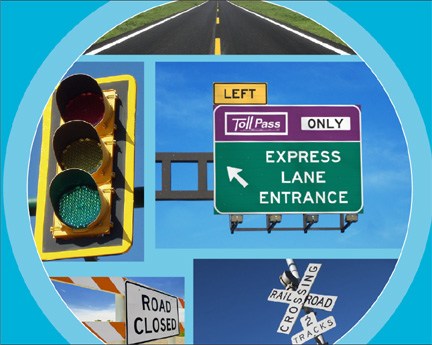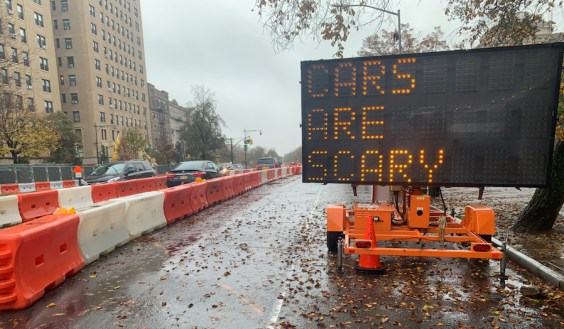The men and women who write the Manual on Uniform Traffic Control Devices are an obscure bunch. But their influence over our living environments and how we get around extends almost everywhere you go in America.
This group of a few hundred engineers, which goes by the unpronounceable acronym NCUTCD (it stands for the National Committee on Uniform Traffic Control Devices), is responsible for setting engineering standards for street configurations, striping, signs, and signals. The industry templates for everything from crosswalks to bike lanes to freeway exit signs can't be changed without their say-so.
Do your city's street engineers feel comfortable implementing protected bike lanes? Probably not without the blessing of the NCUTCD, and they have been withholding it for a long time. The group is notoriously slow to evolve and still hasn't given its stamp of approval for protected bike lanes. While many local governments aren't waiting for NCUTCD to catch up to modern practice, many others are reluctant to depart from their standards.
Lee Billingsley, who chaired the NCUTCD since 2004, recently stepped down from the top spot on the committee. I interviewed Billingsley back in March, and he defended the slow pace of change. At a time when America's traffic safety record is falling even farther behind global peer nations, with drivers killing 6,000 people walking on our streets each year, Billingsley said conventions in the MUTCD like pedestrian signal timing have "stood the test of time.”
Two veteran members of the NCUTCD were nominated to replace Billingley, and it was Gene Hawkins, a professor of civil engineering at Texas A&M, who was elected. Hawkins was previously vice chair under Billingsley.
We initially contacted Hawkins and the other nominee, Jon Upchurch, a retired engineer who teaches at the University of Northern Arizona, in September, in order to get a feel for their sensibilities before the vote. Even though NCUTCD staff had informed Streetsblog that Hawkins and Upchurch were nominated, both refused to comment at the time, saying the nominations were not official yet.
We followed up with Hawkins more recently and he replied to our questions via email.
Will he lead the NCUTCD in a way that's open to change? Any successful reform effort to will have to produce a culture shift at NCUTCD, where sluggishness to embrace new ideas seems to be a point of pride. When refusing to sign off on new design treatments, committee members often couch their position as a defense of data and research -- without sufficient study, their argument goes, it would be irresponsible to allow new things.
The case for defending the status quo in the U.S. has never been that strong, however, and it continues to erode as the nation's terrible traffic fatality rate keeps getting worse. In 2016, traffic deaths topped 40,000, the worst total in almost a decade, and a major reversal of a long-time trend.
America's traffic safety establishment is finally coming to grips with the failures of longstanding street design practice. The National Transportation Safety Board, for instance, recently came out with a landmark report on the need to reduce exposure to lethal vehicular speeds. Engineering practices like the 85th Percentile Rule, which essentially holds that streets are designed well when 85 percent of drivers travel at or below the posted speed limit, should be replaced by standards that explicitly prioritize safety, the NTSB recommended.
Our questions for Hawkins centered on how the NCUTCD will adapt to the increasingly prevalent understanding of the ways conventional American street engineering puts people at risk. Below is the Q&A, lightly edited for length and clarity.
NTSB recently advised against strict adherence to the 85th Percentile Rule in light of the growing traffic fatality rate. The MUTCD still advises more or less strict adherence to it. Would you support changing that?
The NCUTCD is aware of the NTSB report and one of the technical committees is reviewing it.
The strength of the NCUTCD is its consensus-building process that considers input from many reviewers among its sponsoring organizations. If the technical committee recommends changes to MUTCD language based on the NTSB report, the recommended language will be distributed to the sponsoring organizations for review. The review comments will be considered by the technical committee and may lead to changes in the recommendation.
If approved by the technical committee after sponsor review, the proposal would then be presented to the NCUTCD Council for debate, possible change, and potential approval. It is only after approval by the Council that the NCUTCD would submit a recommendation for a change to MUTCD language to the FHWA, who owns the MUTCD.
To become official MUTCD language, that change would then need to go through the federal rulemaking process, a process that includes the opportunity for public comment. As chair of the NCUTCD, my job is to manage and administer the organization to optimize the process of developing MUTCD recommendations. It is not my responsibility to support or oppose any particular proposal.
Engineers like Boston's Peter Furth have been critical of some aspects of the MUTCD, saying for example that signal timing conventions put pedestrians at risk in places like Boston. What is your response? Do you think any of that is due for revision in light of the skyrocketing pedestrian and cycling death rate?
I have yet to find a person who believes that the 2009 MUTCD is perfect and does not need to be changed. The many members of the NCUTCD volunteer thousands of person-hours each year developing recommended changes to the MUTCD for FHWA to consider for future rulemaking efforts.
I would encourage anyone that has thoughts on how the MUTCD should be improved to get involved with the NCUTCD and work with our other volunteers to develop recommended improvements to the MUTCD. If they do not want to get involved with the NCUTCD, their other option for impacting future MUTCD language is to wait until a proposed change is published in the Federal Register and then submit a comment to the public docket.
How would you like the committee to respond to the recent declines in traffic safety?
I know that all of the members of the NCUTCD consider safety as a significant issue as they develop, review, revise, and approve recommended changes to MUTCD language. As they have in the past, I would expect NCUTCD members to give utmost consideration to the safety of the traveling public in all their deliberations.






